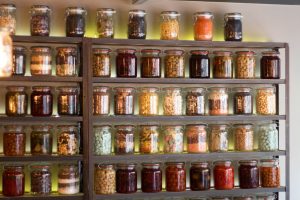We are a yogurt-making family! Where it once seemed wild and crazy to make our own yogurt, making a gallon a week is now just part of my kitchen routine. I originally followed the instructions in Wild Fermentation, except for the heating the milk part. Because we purchase raw milk I like the yogurt to also be raw so we can benefit from all those good raw enzymes plus the healthy probiotics.
I tried a few different techniques, one was heating the milk on the lowest flame on the stove, whisking it constantly, hoping it wouldn’t get too hot. That one works well if you’re vigilant. Don’t worry about a thermometer if you’re trying to keep it raw. I find that if I can comfortably dip my finger in, it hasn’t gotten hot enough to kill the good probiotics. If you’re using pasteurized milk and trying to heat it to a certain temperature, go for the thermometer. A good technique for the easily-distracted is to simply run really hot water in a big silver bowl in the sink and set the jars of milk in it until they are warmed through. About the temperature of a nice hot water bottle you’d take to bed on a chilly evening is just about right.
I tried keeping the jar warm by snuggling it in a cooler surrounded by warm towels, but that didn’t work as well as heating up the crock pot to just over 100, turning it off and keeping the jar in there to do its thing. The thick ceramic pot held the heat really well. And I still cushioned the jar with towels. Lately I’ve had out crock pot going all night long, cooking up big batches of broth. I find that setting the jar of milk near (but not touching!) the hot crock pot keeps it warm enough. Then I don’t have to mess with tucking it in for the night.
I was pleased to discover just how easy making your own yogurt is. Once I got the technique down, it was so simple to incorporate into my weekly routine. It doesn’t take more than ten minutes of hands-on time. All you do is heat up your quart of milk, stir in a tablespoon of yogurt with live cultures (once I had my own, I just saved a bit from each previous batch for the next one) for each quart of milk (four for a gallon).
Then let it sit for about 16-24 hours. The climate in your own house will be unique and you’ll figure out the optimal time for your yogurt. Mine took a little longer than the book said. I usually start it in the evening and let it sit overnight.
Once the yogurt was all thickened up I mixed in a little vanilla and maple syrup to taste.
Not to toot my own horn or anything, but it was seriously the best yogurt I’ve ever had! It must be something about the excellent goat milk and not having any additives like stabilizers, gelatin or one-dimensional-tasting sweeteners. While the ingredients were so simple, the taste was complex and delightful. Yogurt making is so simple and delicious, there’s no reason not to do it yourself!
Homemade Yogurt
Source: www.plantoeat.com
Course: Breakfast
Serves:
Ingredients
- 1 quart milk
- 1 tablespoon yogurt, with live cultures
Directions
- Heat up milk. Stir in yogurt. Let sit 16-24 hours at about 100 degrees.
- Once the yogurt was all thickened up I mixed in a little vanilla and maple syrup to taste.
- I find that if I can comfortably dip my finger in, it hasn’t gotten hot enough to kill the good probiotics. If you’re using pasteurized milk and trying to heat it to a certain temperature, go for the thermometer. A good technique for the easily-distracted is to simply run really hot water in a big silver bowl in the sink and set the jars of milk in it until they are warmed through.
- I tried keeping the jar warm by snuggling it in a cooler surrounded by warm towels, but that didn’t work as well as heating up the crock pot to just over 100, turning it off and keeping the jar in there to do its thing. The thick ceramic pot held the heat really well. And I still cushioned the jar with towels. Lately I’ve had out crock pot going all night long, cooking up big batches of broth. I find that setting the jar of milk near (but not touching!) the hot crock pot keeps it warm enough.






